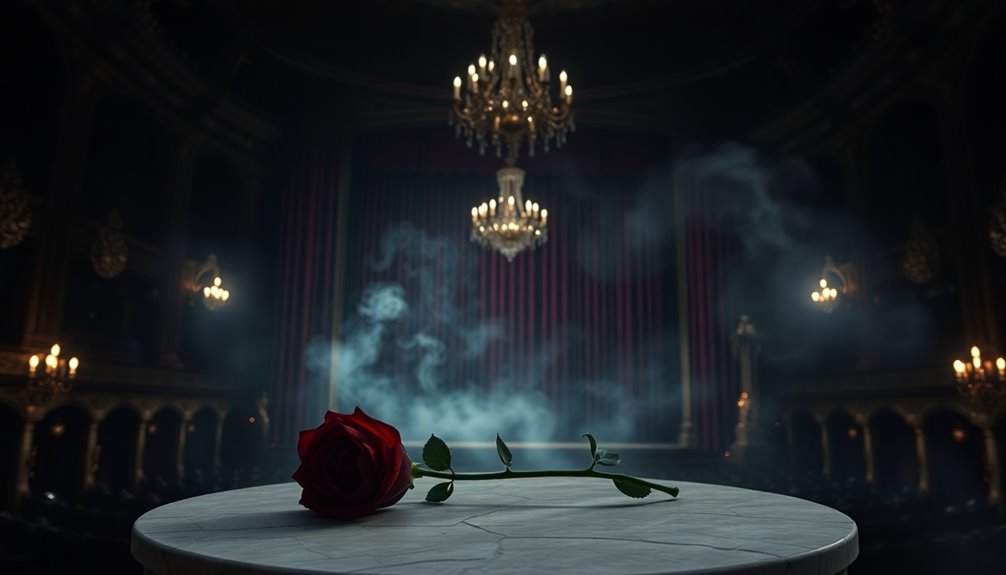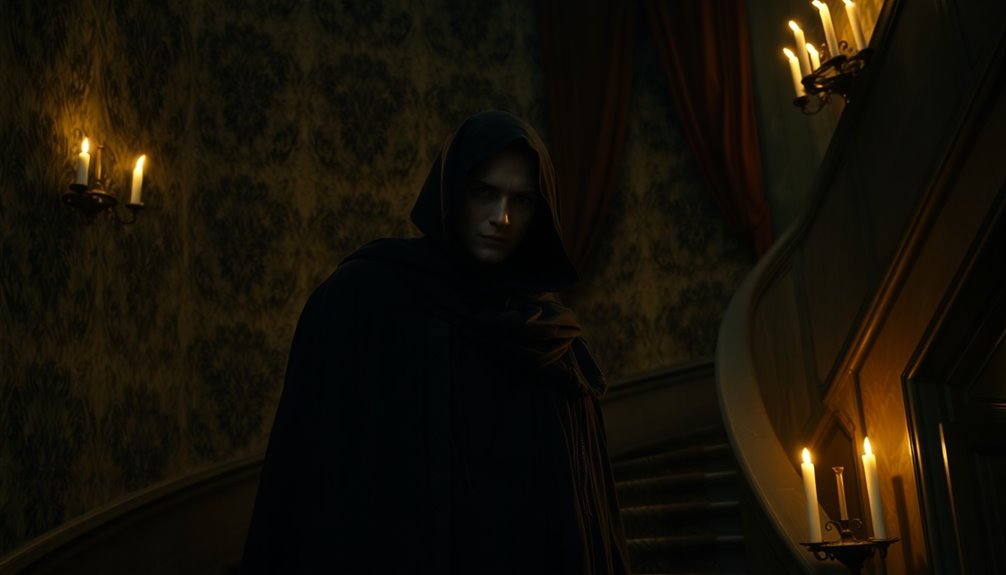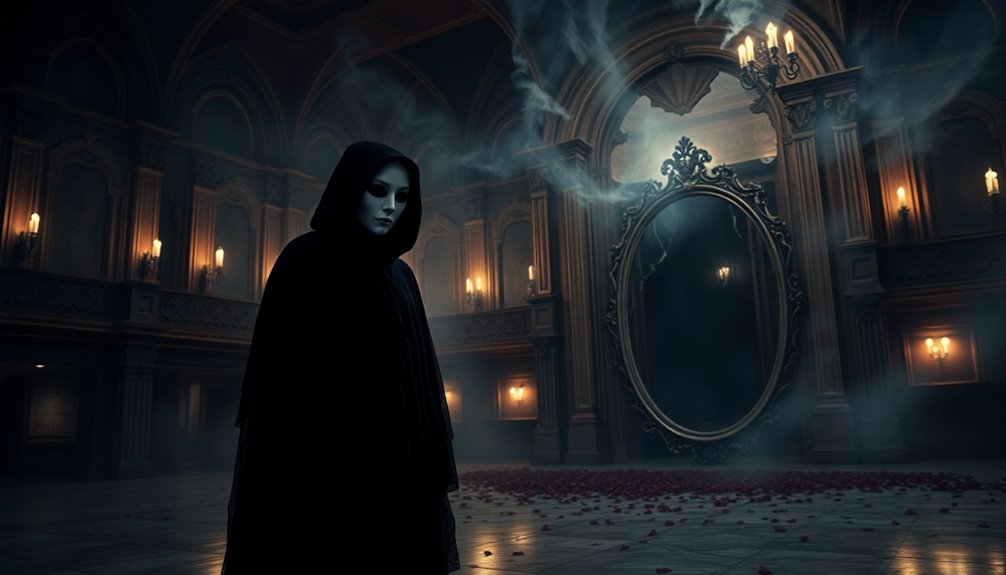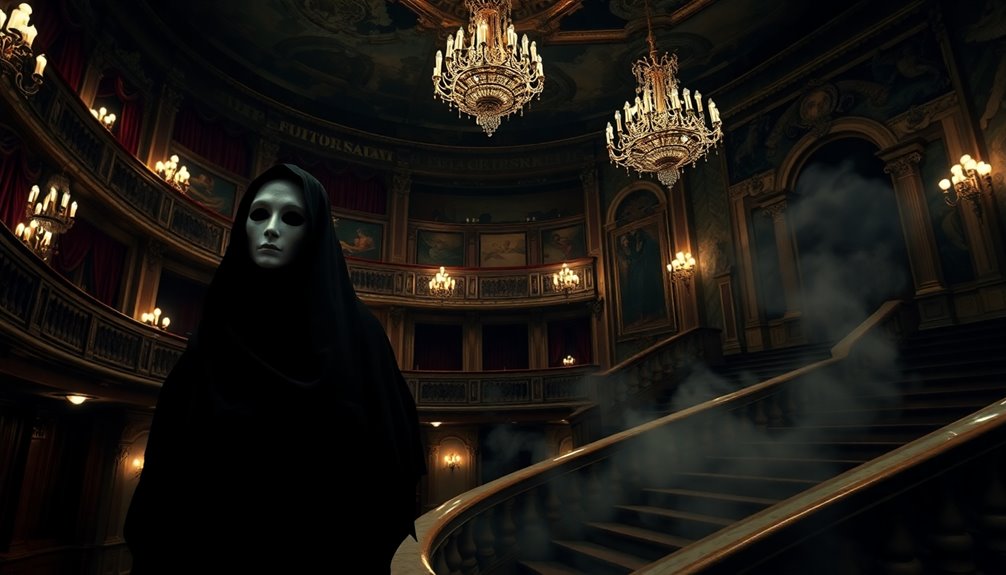If you're exploring the Gothic roots of *The Phantom of the Opera*, you'll encounter themes of isolation and obsession woven through Erik's tragic character. The eerie setting of the Palais Garnier opera house enhances its haunting beauty, while historical events, like the chandelier accident, add depth to its dark narrative. Erik's complex nature and his fixation on Christine Daaé illuminate the struggles of love and rejection. There's much more to uncover about its lasting legacy and influence in modern culture.
The Origins of The Phantom of the Opera

Although *The Phantom of the Opera* has captivated audiences for over a century, its origins trace back to Gaston Leroux's 1910 novel, inspired by the haunting beauty of the Palais Garnier opera house and the eerie tales surrounding it.
Leroux masterfully weaves gothic themes into his narrative, showcasing the grotesque figure of the Phantom, Erik, whose intelligence contrasts sharply with his isolation. This duality of beauty and horror resonates throughout the story, drawing you into a world filled with tension and emotion. The chilling accounts of Jack the Ripper during the Victorian era add to the intrigue of the gothic atmosphere, reflecting the timeless nature of Gothic storytelling.
The infamous chandelier accident of 1896 adds a chilling touch, enhancing the novel's gothic atmosphere. Through characters like Christine Daaé, inspired by real-life sopranos, Leroux explores love and ambition, solidifying the Phantom of the Opera as a cornerstone of gothic literature. The atmospheric descriptions of the opera house immerse readers in the eerie ambiance, maintaining tension and suspense throughout the story, much like the dark legacy hidden within *Rebecca's* Manderley.
The Gothic Elements in Gaston Leroux's Novel
Gaston Leroux's *The Phantom of the Opera* is steeped in Gothic elements that enhance its haunting narrative. The eerie setting of the Palais Garnier, with its dark corridors and underground catacombs, creates a chilling backdrop for the story.
Erik, the Phantom, embodies the tragic Gothic hero, whose grotesque appearance and psychological turmoil evoke both fear and sympathy. His profound isolation and obsession with Christine Daaé drive him to desperate acts, illustrating the darker sides of human emotion.
Music plays a vital role, heightening emotional tension and intertwining with the narrative's supernatural elements. The novel's exploration of obsession and jealousy resonates with themes in other Gothic literature, creating a rich tapestry of emotional complexity.
Leroux's mix of first-person accounts and investigative journalism adds layers of mystery and suspense, solidifying the Gothic atmosphere that captivates readers throughout the novel.
The Complex Character of Erik

When you consider Erik's character, you see a man torn between his monstrous identity and his desperate longing for love.
His obsession with Christine Daaé reveals a tragic depth, as he oscillates between affection and violence. This complexity makes Erik a compelling figure, embodying the gothic themes of isolation and the dark side of passion. In many ways, Erik's struggles mirror those faced by marginalized individuals in historical narratives, where society often casts out those who are different. Erik's tragic fate can be likened to the reflections on systemic oppression that resonate in the struggles of characters like Bigger Thomas from Richard Wright's *Native Son*, highlighting how societal rejection shapes identity and drives desperation. Coates' insights into systemic racism further illuminate how such societal forces can devastate individuals, much like Erik's own tragic journey.
Erik's Monstrous Identity
Erik, the Phantom of the Opera, embodies a haunting blend of genius and monstrosity that captivates and repulses readers. His grotesque appearance—thin frame, deep-set eyes, and skull-like face—reinforces his monstrous identity.
Unlike typical romantic heroes, Erik lacks magical powers; instead, he's a tortured man whose brilliance coexists with brutality, complicating your sympathy for him. Leroux draws parallels between Erik and other isolated figures like H.G. Wells' Invisible Man, emphasizing themes of obsession.
The 1925 film adaptation, featuring Lon Chaney, further solidifies Erik's tragic persona, resonating with audiences through his existential despair. His passionate love for Christine Daaé drives the narrative tension, revealing the destructive potential of his duality as both a lover and a monster.
Tragic Love and Obsession
The duality of Erik's character reveals itself through his tragic love for Christine Daaé, a force that drives him to both obsession and violence.
His grotesque exterior belies a genius intellect and an angelic voice, creating a haunting contrast that complicates your understanding of love. You can't help but feel sympathy for Erik as he navigates his tortured existence, marked by isolation and despair.
His relentless pursuit of Christine showcases how obsession can twist love into something dark and destructive.
Erik challenges the traditional romantic hero, embodying the horror and tragedy that lurks in the shadows of passion.
Ultimately, his tragic love for Christine illustrates the consuming nature of obsession, leaving both lover and beloved trapped in a web of despair.
Christine Daaé: A Study in Duality
Christine Daaé embodies a fascinating duality that draws you into the heart of "The Phantom of the Opera." She navigates her relationships with the Phantom and Raoul, shifting between innocence and cunning as she grapples with the complexities of love and obsession.
Gaston Leroux crafts her character as more than just a damsel in distress; she challenges traditional gender roles by ultimately taking control of her own fate. Acts of compassion towards the Phantom evoke sympathy while fostering internal conflict. This complexity mirrors the resilience amidst adversity that characters demonstrate in narratives like "The Book Thief," where individuals confront oppressive circumstances with courage. The emotional rollercoaster of joy and sorrow experienced by Christine reflects the fragility of life that is often explored in literature.
Christine oscillates between light and darkness, symbolizing her ties to both the mundane and the supernatural. Her evolution throughout this love story highlights themes of self-empowerment, making Christine a pivotal figure in the exploration of gothic elements within the narrative. This duality also parallels Tita's journey in "Like Water for Chocolate," as both characters navigate the conflict between tradition and individuality in their respective stories.
Themes of Isolation and Obsession

Love in "The Phantom of the Opera" unfolds as a complex interplay of emotions, with isolation and obsession driving the characters' actions. The Phantom, Erik, embodies profound isolation, confined beneath the Palais Garnier, where his despair morphs into an obsessive love for Christine Daaé. His fixation leads him to commit cruel acts, illustrating how isolation can distort affection into something destructive. This mirrors the experiences of characters like Frank Wheeler from "Revolutionary Road," who also grapple with suburban disillusionment and the consequences of unfulfilled desires.
Christine's struggle with Erik's obsession reveals her desire for autonomy, caught between submission to his dark allure and her yearning for freedom. The love triangle involving Christine, Raoul, and Erik showcases the emotional turmoil each character faces. Furthermore, the narrative resonates with the dark allure of obsession that can lead individuals to manipulate those around them for validation. In this sense, Erik's character reflects the complexities of self-reflection that can arise from deep emotional scars and past actions.
Ultimately, Erik's haunting presence in Christine's life symbolizes the psychological toll that isolation exacts, weaving together themes of obsession and loneliness throughout the narrative.
The Influence of Music on the Narrative
While the narrative of *The Phantom of the Opera* unfolds with dramatic tension, music plays an essential role in shaping its emotional landscape. The haunting melodies not only evoke feelings but also reflect the characters' inner conflicts.
Consider how music:
- Enhances the eerie atmosphere of the opera house, making it feel alive.
- Captivates Christine, drawing her into the Phantom's world of obsession and beauty.
- Serves as a tool for the Phantom, Erik, to manipulate those around him, revealing his dual nature.
Key pieces like "Music of the Night" deepen the complexity of relationships, illustrating love, obsession, and despair. Additionally, the themes of bravery and resilience in the narrative echo the journeys of strong female protagonists in literature, showcasing the power of emotional expression. The influence of Victorian London provides a rich backdrop for understanding the societal challenges that shape the characters' experiences.
Through music, Leroux crafts a gothic tale that resonates with emotional depth, making the narrative unforgettable.
Real-Life Inspirations Behind the Story
Drawing from real-life events and figures, *The Phantom of the Opera* becomes a tapestry of inspiration woven into its haunting narrative.
The infamous chandelier accident at the Palais Garnier in 1896, which resulted in tragedy, adds a chilling layer to the opera house's history. Gaston Leroux's belief in its haunting echoes the local lore.
The character of Christine Daaé likely draws from real sopranos like Christina Nilsson and ballerina Nanine Dorival, who were prominent in Leroux's era.
Additionally, the underground lake beneath the opera house not only serves as a setting but reflects its actual construction purpose.
The love triangle involving Christine, Raoul, and the Phantom mirrors the dynamics inspired by a real-life ballet dancer and further enriches the story's complexity.
The Impact of Adaptations on Gothic Perception
When you explore adaptations of *The Phantom of the Opera*, you'll notice how they reshape themes and alter character portrayals.
Instead of focusing on the original's darker elements, many interpretations romanticize the story, turning the Phantom into a misunderstood hero.
This shift not only changes how you perceive the characters but also impacts your understanding of the gothic roots of the narrative.
Adaptation Influence on Themes
As adaptations of *The Phantom of the Opera* emerge, they reshape the gothic themes that originally defined Gaston Leroux's narrative.
These adaptations often emphasize romantic elements, leading to significant changes in how we perceive the story's gothic roots.
- The 1925 film portrays the Phantom as a tragic romantic hero, softening his grotesque nature.
- Andrew Lloyd Webber's musical highlights love, downplaying violence and psychological terror found in the original novel.
- Love Never Dies redefines the Phantom, presenting him sympathetically, diverging from themes of hatred and isolation.
This adaptation influence on themes results in a more sanitized version of Leroux's intricate gothic horror, altering the cultural legacy and the depth of the original narrative.
Characterization Changes in Interpretations
While adaptations of *The Phantom of the Opera* have transformed the characterization of key figures like Erik and Christine, the essence of gothic horror remains impacted by these reinterpretations.
In Andrew Lloyd Webber's version, Erik shifts from a malevolent figure to a brooding romantic hero, emphasizing his tragic love for Christine Daaé. This contrasts sharply with the 1925 film, where Lon Chaney's portrayal highlights Erik's monstrous nature through striking visuals.
Leroux's original Erik embodies megalomania and violence, aspects often downplayed in modern adaptations.
Meanwhile, Christine evolves from a naïve damsel to a more empowered figure, reflecting changing gender roles.
These shifts influence how audiences perceive gothic horror, complicating the legacy of its iconic characters.
The Lasting Legacy of Gothic Horror in Modern Culture
Though Gothic horror has ancient roots, its legacy continues to thrive in modern culture, enchanting audiences with timeless themes of love, obsession, and isolation.
You'll find that its influence is evident in various forms:
- Film and Television: Contemporary horror often draws from Gothic elements, showcasing complex character dynamics.
- Literature: Modern novels frequently explore emotional conflicts similar to those in classic Gothic tales.
- Fashion and Art: Dark aesthetics inspired by Gothic horror remain popular in visual culture.
The Phantom of the Opera exemplifies these themes, with its intricate storytelling and haunting characters.
Gaston Leroux's portrayal of Erik as a grotesque figure encapsulates the emotional conflicts that resonate today, ensuring the enduring fascination with Gothic horror across generations.
Conclusion
In exploring the gothic roots of *The Phantom of the Opera*, you've unwrapped a haunting tapestry of isolation, obsession, and the interplay between beauty and monstrosity. Just as Erik's mask conceals his true self, the story's layers reveal the complexities of human emotion and desire. This timeless tale continues to resonate, proving that even in darkness, the echoes of love and tragedy can illuminate the depths of our own souls. What masks do you wear in your own life?



